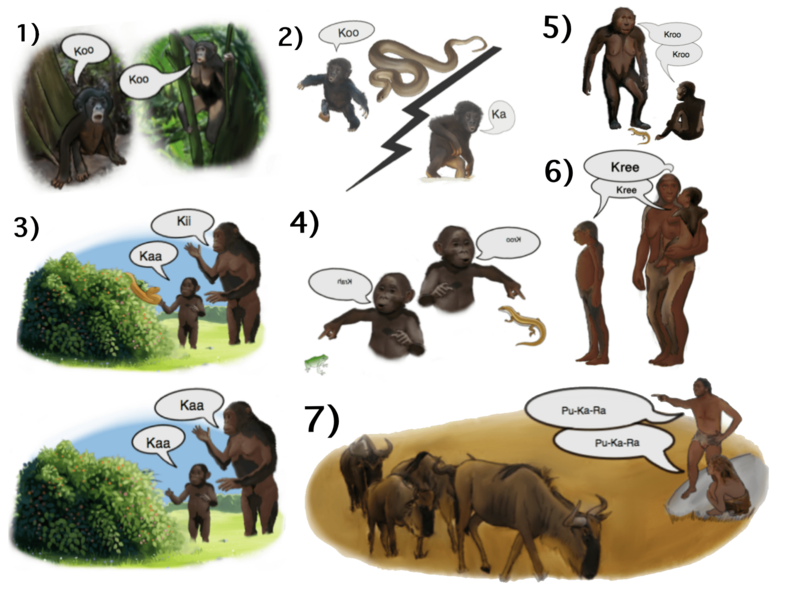Image: From where to what

Description: The 'from where to what' model of language evolution hypotheses 7 stages of language evolution: 1. The origin of speech is the exchange of contact calls between mothers and offspring used to relocate each other in cases of separation. 2. Offspring of early Homo modified the contact calls with intonations in order to emit two types of contact calls: contact calls that signal low level of distress and contact calls that signal high-level of distress. 3. The use of two types of contact calls enabled the first question-answer conversation. In this scenario, the offspring emits a low-level distress call to express a desire to interact with an object, and the mother responds with a low-level distress call to enable the interaction or high-level distress call to prohibit it. 4. The use of intonations improved over time, and eventually, individuals acquired sufficient vocal control to invent new words to objects. 5. At first, offspring learned the calls from their parents by imitating their lip-movements. 6. As the learning of calls improved, babies learned new calls (i.e., phonemes) through lip imitation only during infancy. After that period, the memory of phonemes lasted for a lifetime, and older children became capable of learning new calls (through mimicry) without observing their parents' lip-movements. 7. Individuals became capable of rehearsing sequences of calls. This enabled the learning of words with several syllables, which increased vocabulary size. Further developments to the brain circuit responsible for rehearsing poly-syllabic words resulted with individuals capable of rehearsing lists of words (phonological working memory), which served as the platform for communication with sentences. Based on the papers: Poliva, O. (2015). From where to what: a neuroanatomically based evolutionary model of the emergence of speech in humans. F1000Res. doi:10.12688/f1000research.6175.3. Poliva, O. (2016). From Mimicry to Language: A Neuroanatomically Based Evolutionary Model of the Emergence of Vocal Language. Front. Neurosci. 10, 1–21. doi:10.3389/fnins.2016.00307.
Title: From where to what
Credit: Own work
Author: KarinaCor
Permission: This work is free and may be used by anyone for any purpose. If you wish to use this content, you do not need to request permission as long as you follow any licensing requirements mentioned on this page. The Wikimedia Foundation has received an e-mail confirming that the copyright holder has approved publication under the terms mentioned on this page. This correspondence has been reviewed by a Volunteer Response Team (VRT) member and stored in our permission archive. The correspondence is available to trusted volunteers as ticket #2019080310002559. If you have questions about the archived correspondence, please use the VRT noticeboard. Ticket link: https://ticket.wikimedia.org/otrs/index.pl?Action=AgentTicketZoom&TicketNumber=2019080310002559 Find other files from the same ticket:
Usage Terms: Creative Commons Attribution-Share Alike 4.0
License: CC BY-SA 4.0
License Link: https://creativecommons.org/licenses/by-sa/4.0
Attribution Required?: Yes
Image usage
The following page links to this image:

